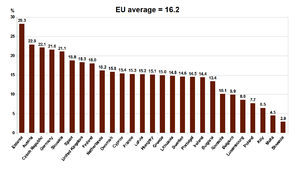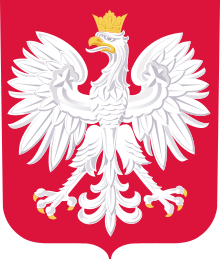Women in Poland
 Portrait of a young woman from Poland. | |
| Gender Inequality Index[1] | |
|---|---|
| Value | 0.139 (2013) |
| Rank | 26th out of 152 |
| Maternal mortality (per 100,000) | 5 (2010) |
| Women in parliament | 21.8% (2013) |
| Females over 25 with secondary education | 79.4% (2012) |
| Women in labour force | 56.6% (employment rate OECD definition, 2015)[2] |
| Global Gender Gap Index[3] | |
| Value | 0.7031 (2013) |
| Rank | 54th out of 144 |
The character of women in Poland have been shaped by the history of Poland, the culture of Poland, and the politics of Poland.[4] They belong to the group categorized as women in Europe.
History

The history of women on the territory of present day Poland is varied, and has been stronly influenced by Roman Catholicism in Poland. Feminism in Poland has a long history, and has traditionally been divided into seven periods, beginning with the 19th century first-wave feminism.[6] The first four early periods coincided with the foreign partitions of Poland, which resulted in the elimination of the sovereign Polish state for 123 years.[7]
Poland was early to give women legal rights: women's suffrage was granted in 1918,[8] after the country regained independence that year, following the 123-year period of partition and foreign rule.
During the communist era, women were granted equal legal rights, and the official government rhetoric was one of supporting gender equality, but as in other communist states, civil rights of both men and women were merely symbolic, as the system was an authoritarian one. Despite remaining de facto subordinated to male authority, women did see some gains under the communist regime, such as better access to education and to a more equal involvement in the workforce. The fall of the communist regime meant the shaking of the economy of the country, and initial economic and social destabilization. The transition period was a difficult one for women, although men were negatively affected, too. As of 2015, the employment rate for women (aged 15-64) was 56.6%, compared the men's rate of 69.3%.[9] Although Poland has an image of a conservative country, being often depicted as such in the Western media, Poland actually has high numbers of professional women, and women in business,[10] and it also has one of the lowest gender pay gaps in the European Union.[11]
Notable women in Polish history
The important women in Poland's early history include Swietoslava (sometimes confused as being Sigrid the Haughty or Gunhilda; also known as Storrada), the daughter of Mieszko the First and Dobrawa of Bohemia; Katarzyna Jagiellonka (also known as Catherine Jagiello or Katarrina Jegellonica); Dobrawa herself (wife of Mieszko the First), the daughter of the Duke of Bohemia; Jadwiga (Hedwig), the daughter of a Hungarian king.[12]
Gallery


 A group of girls in rural Poland, 1959
A group of girls in rural Poland, 1959- Two teenage girls in contemporary Poland
References
Specific
- ↑ "Table 4: Gender Inequality Index". United Nations Development Programme. Retrieved 7 November 2014.
- ↑ http://stats.oecd.org/Index.aspx?DatasetCode=LFS_SEXAGE_I_R#
- ↑ "The Global Gender Gap Report 2013" (PDF). World Economic Forum. pp. 12–13.
- ↑ "Polish women". polishmarriage.org. Retrieved 2 November 2013.
- ↑ European Commission. The situation in the EU. Retrieved on July 12, 2011.
- ↑ Łoch, Eugenia (ed.) 2001. Modernizm i feminizm. Postacie kobiece w literaturze polskiej i obcej. Lublin: Wydawnictwo Uniwersytetu M.Curie-Skłodowskiej, p.44
- ↑ Davies, Norman. God's Playground: a history of Poland. Revised Edition. Oxford: Clarendon Press, 2005.
- ↑ https://www.britannica.com/topic/woman-suffrage
- ↑ http://stats.oecd.org/Index.aspx?DatasetCode=LFS_SEXAGE_I_R#
- ↑ http://www.grantthornton.global/en/press/press-releases-2015/women-in-business-2015/
- ↑ http://ec.europa.eu/justice/gender-equality/gender-pay-gap/situation-europe/index_en.htm
- ↑ "Women in Poland's Early History". Retrieved 2 November 2013.
General
- Lewis, Jone Johnson. Poland - Women, Encyclopedia of Women's History.
External links
| Wikimedia Commons has media related to Women of Poland. |

